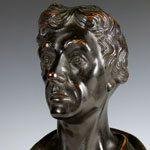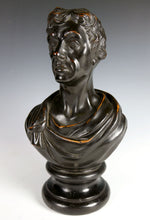A George III Bust of Admiral Lord Nelson, dated April 1814
Adding product to your cart
Height: 28cm (11in)
Plaster. Modelled in classical robes and mounted on an integral socle. Inscribed to the reverse Nelson Pub. April 23 1814 by J. Grunsell, 46 Strand.
The appeal of the present bust piece is twofold. It is unrecorded in published works on Nelson portraits and that it dates to the Napoleonic period as the verso inscription testifies.
Napoleon’s exile to the Mediterranean island of Elba on 11 April 1814 and the apparent conclusion of the long running wars against France, caused ‘entrepreneurs’ in the Strand and elsewhere to seize upon the false dawn and issue for sale a variety celebratory wares. Nelson as a subject was an indisputable choice being the national hero who nine years earlier had thwarted Bonaparte’s plans to invade England by his victory and death at Trafalgar. The present bust is clearly a vernacular piece; plaster being the cheap and popular medium for an entire figure making trade that flourished in London from the mid 18th century to about 1830. Acts of Parliament in 1798 and 1814 relating to ‘Making New Models and Casts of Busts’, gave producers a form of copyright which conferred exclusive rights for 14 years on persons who created new models or casts of human or animal figures if marked with publication details.
Read more
The present bust bears similarities in the treatment of the hair and classical robes to marble bust exhibited at the Royal Academy in 1810. This last was the creation of James George Bubb (c.1781-1853) who coincidentally was the son of a Strand tobacconist. His biography further tells us he ‘exhibited from an address in that same thoroughfare as a young man’, and that in 1806 rival sculptor Lawrence Gahagan referred to him pejoratively as ‘Tobacconist Bubb’ (Gunnis). Indeed it is said that Gahagan and others in the sculpting profession had a low opinion of Bubb both as an artist and an individual, citing in particular his opportunism. Bubb’s marble bust of 1810 has been seen as a deriving from the portrait bust of Nelson in Rear Admiral’s uniform by the Austrian master Franz Thaller and his assistant Matthias Ranson, which was likewise copied by the Gahagan family and other imitators such as Mr Grunsell of whom details are non existent (Walker).
Directory of London and Westminster & Borough of Southwark (1794)
Gunnis, R. (1953) Dictionary of British Sculptors, 1660–1851, London
Walker, R. (1998) Nelson Portraits, Royal Naval Museum






